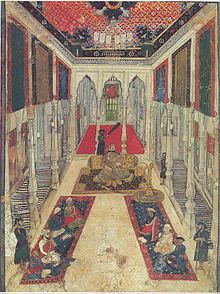मानकरी
मानकरी भारतीय उपमहाद्वीप के मराठा कुलीनवर्ग [1] [2] और सैनिकों [3] द्वारा इस्तेमाल किया जाने वाला एक वंशानुगत शीर्षक है, जिनके पास भूमि अनुदान, और नकद भत्ता था। [4] वे दरबार (अदालत) में एक आधिकारिक पद पर थे और अदालतों, परिषदों, शादियों, त्योहारों, ग्राम सभाओं आदि में दिए जाने वाले कुछ औपचारिक सम्मानों और उपहारों के हकदार थे। वे गौरव के योग्य थे और उन्हें दिया गया सम्मान उनके या उनके विशिष्ट पूर्वजों के सैन्य, नौकरशाही या वित्तीय महत्व का परिणाम था। [5] [6]


इस शब्द का व्यापक रूप से मराठा कुलीनवर्ग द्वारा उपयोग किया गया था, जो मराठा साम्राज्य की विभिन्न रियासतों में महत्वपूर्ण पदों पर थे। [7] [8]
यह सभी देखें
संपादित करेंसंदर्भ
संपादित करें- ↑ Imperial Record Dept India (1959). Calendar of Persian Correspondence. Superintendent Government Printing. अभिगमन तिथि 2015-01-11.
- ↑ Pandey, R. G. (1980). Mahadji Shinde and the Poona Durbar. Oriental Publishers & Distributor. अभिगमन तिथि 2006-01-10.
- ↑ Vaidya, S. G. (1975). Peshwa Bajirao II and the Downfall of the Maratha Power. Pragati Prakashan. अभिगमन तिथि 2005-03-11.
- ↑ Central India; Luard, C.E. (1908). The Central India State Gazetteer Series. Thacker, Spink. अभिगमन तिथि 2015-07-12.
- ↑ Madan, T.N. (1988). Way of Life: King, Householder, Renouncer : Essays in Honour of Louis Dumont. Motilal Banarsidass. पृ॰ 129. आई॰ऍस॰बी॰ऍन॰ 9788120805279. अभिगमन तिथि 2015-07-04.
- ↑ Russell, Robert Vane (1916). "Pt. II. Descriptive articles on the principal castes and tribes of the Central Provinces".
- ↑ O'Hanlon, R. (2002). Caste, Conflict and Ideology: Mahatma Jotirao Phule and Low Caste Protest in Nineteenth-Century Western India. Cambridge University Press. पृ॰ 45. आई॰ऍस॰बी॰ऍन॰ 9780521523080. अभिगमन तिथि 2015-07-12.
- ↑ Gokhale, Balkrishna Govind (1988). Poona in the eighteenth century: An urban history. आई॰ऍस॰बी॰ऍन॰ 978-0-19-562137-2.